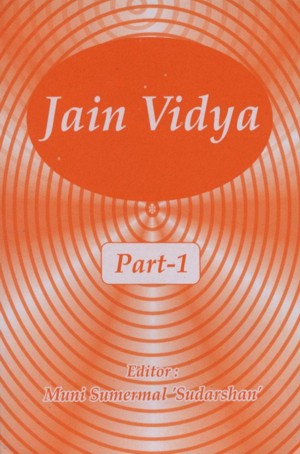Lesson - 12
Bhagavan Mahavira
(Lord Mahavira)
Birth and Nomenclature
Among the great men of the world, the name of Tirthankara Mahavira is remembered reverentially. He was the twenty fourth tirthankara of Jainism.
About two thousand six hundred years ago, Vaishali republic flourished in eastern Bihar. A city named ‘kshatriya kundagram’ was also situated in that kingdom. It was ruled by kshatriya king Siddhartha. His wife was Trishala, who gave birth to a son on chaitra shukla troyodashi. He was named as Vardhamana.Lord Mahavira was known by three names - Vardhamana, Mahavira and Gyataputra. From the day of his birth, the prosperity of the family increased rapidly; hence the name Vardhamana (Pros Peror) was given. During the period of spiritual practice, he bore all the troubles bravely; hence the name Mahavira was given. He belonged to the Gyat clan, hence the name Gyataputra was given. The names of his elder brother and sister were Nandivardhana and Sudarshana respectively.
Childhood and Education
Prince Vardhamana was brought up in royal palace. His early life passed in sports and merriments. Since childhood, Mahavira was fearless. Once a snake intercepted during his childhood sports. Catching it sportively, he threw it off and commenced his merriments as before. When he turned eight, his father sent him to Gurukula (residential place of learning) for education. He possessed great intellect since childhood. He displayed complete mastery over three kinds of knowledge-sensual, verbal and clairvoyance before his teachers.
Youth
Having crossed childhood, he attained adolescence. He was a born vairagi (indifferent to worldly pleasures). He had no mind for getting into wedlock, but under parental pressure, he got married to Yashoda, a Kshatriya girl. She bore a daughter named Priyadarshana. She got married to Sudarshana’s son Jamali.
Renunciation From World and Initiation as a Monk.
When he attained twenty eight years of age, his father Siddhartha and mother Trishala died. He took permission from his elder brother Nandivardhana for undertaking asceticism. Nandivardhana did not allow him for adopting monkhood and insisted him to remain with him as a householder. Due to elder brother’s repeated insistence, Mahavira remained in house for two more years. During that period, he did not drink sachitta (unboiled water; with life in it) water, abstained from taking meals after sunset, observed celibacy and as soon as he was thirty, he embraced asceticism.
Period of Sadhana (spiritual practice)
During sadhana-period, he bore numerous hardships. Taking him for a thief, some people often beat him. Children pelted stones at him and directed the dogs to bite him. The snake named Chandakaushika strung him terribly. The deva named Sangam afflicted him twenty times in a single night. Lord Mahavira was a master, forgiver, he tolerated everything equanimously. He adopted severe penances. His penance was in the form of fasting from two days to the extent of six months at a stretch, and during that period, he abstained from consuming water too.
Attainment of Omniscience
Together with long penance Lord Mahavira was disciplining his soul (self) through meditation during sadhana period. He spoke very little, mostly observed silence. He continued his spiritual practice for twelve years and thirteen fortnights. In the course of ramblings, he arrived in Jambhiyagrama on vaisakha shukla tenth, where the river Rijubalika flowed near by with a teak (shal) tree standing on its bank. Under that tree he was deeply absorbed in meditation in Godohika (Cow milking) posture. He had been observing fast for the last two days. Then Knowledge grew more and more sanctified, the veil of delusion was removed and the Mahavira attained the vitaraga (dispassionate) state. Having attained omniscience, he was now an arhata (one who has realised one’s true potentiality).
Kevalajnana and its Aftermath
After attaining omniscience, the tirthankara delivered his first sermon among gods. He explained in detail, the importance of restraint. Devas by nature remain in sensual pleasures; they cannot observe restraint in their lives. The next sermon was delivered in Pavapuri where eleven learned Brahmins such as Indrabhuti, had already assembled together for another religious performance. They attended the sermon of the tirthankara at the hall of preaching. The Lord dispelled all the doubts lurking in their minds. All those scholars, together with their 4400 disciples, were initiated in Jainism by Mahavira. Many women like Chandanabala etc. also were initiated in Jainism as nuns. On the very first day the number of Mahavira’s disciples increased rapidly. Thus, the fourfold order comprising of monks, nuns, laymen and laywomen was established.
The Lord entrusted the charge of the order to eleven learned Brahmins like Indrabhuti etc. They were all designated as Ganadharas. Chandanbala was entrusted with the responsibility of managing the group of nuns.
Lord’s Nirvana
The Lord wandered in the course of his spiritual ramblings for thirty years in his omniscient state. Various rulers were initiated in the Jain order.
His last ‘Chaturmas’ (four month stay) was in Pavapuri, Bihar. In his last state, he observed two days of fast. He delivered sermon for the last two day and night. He breathed his last there in the midnight of karatika krishna Amavasya. He was now free from all the worldly bondages. People celebrated the event of nirvana by lighting lamps. The same celebration later on came to be known as Deepavali.
Question:
- When and where was Lord Mahavira born?
- How many names were kept for Mahavira?
- Describe Mahavira’s sadhana (spiritual practice) period.?
- At which place did he attain omniscience?
- Why is Deepavali celebrated?
- Mention the number of the disciples of the eleven Ganadharas.
- What is meant by fourfold older?
